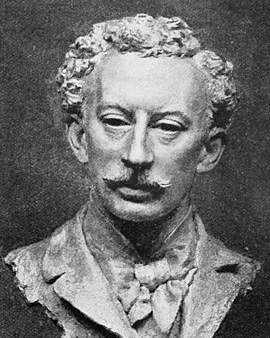


The art style of the English painter Arthur Hacker is considered to be versatile and broadly diversified. His works of art can therefore not be clearly assigned to any one style. The British artist studied at the Royal Academy of Arts from 1876 to 1880. He then gained practical experience in the Parisian studio of the artist Leon Bonnat. It had been his desire for some time to gain practical experience with the famous French artist. After all, Bonnat was an internationally known painter at that time, who influenced modern portrait painting.
During his artistic career, Arthur Hacker dealt with different currents and stylistic devices. Directly after his studies he discovered history painting for himself. The well-known work "At the waters of Babylon" (1888) was created at this time. He was particularly enthusiastic about portrait painting. The passion for details can be seen in all his portraits. The decision to put his artistic emphasis on this style was absolutely right. His works of art received increasing public attention. Furthermore, the Royal Academy offered him an interesting job position. In 1910, he succeeded in becoming a full member of the Royal Academy. Arthur Hacker tried his hand at art. So in 1910 he created a picture which shows the Piccadilly Circus at Nach. For many critics the motif and painting style were a little too modern. Perhaps the artist returned to mythological motifs and portrait painting in the following years because of the criticism.
Many of Hacker's works possess a unique and warm pictorial mood that conveys lightness. Bright colours, light reflections in bright gold tones and the many small details invite the viewer to look at the pictures at length. Historically and religiously influenced works and realistic landscape paintings were typical for the early years of his artistic career. Also as a portrait painter he created unique works, which are still important today. In many of his portraits he depicted dreamy looking female figures in a particularly aesthetic way. Almost all his works are oil paintings on canvas. Hacker found inspiration for his artwork on extensive travels to Spain, Italy or Morocco. Arthur Hacker was artistically active throughout his life. About one year before his death in 1919 he painted an excellent portrait of a well-known engineer and printmaker. The influential artist was buried at Brookwood Cemetery in London.

The art style of the English painter Arthur Hacker is considered to be versatile and broadly diversified. His works of art can therefore not be clearly assigned to any one style. The British artist studied at the Royal Academy of Arts from 1876 to 1880. He then gained practical experience in the Parisian studio of the artist Leon Bonnat. It had been his desire for some time to gain practical experience with the famous French artist. After all, Bonnat was an internationally known painter at that time, who influenced modern portrait painting.
During his artistic career, Arthur Hacker dealt with different currents and stylistic devices. Directly after his studies he discovered history painting for himself. The well-known work "At the waters of Babylon" (1888) was created at this time. He was particularly enthusiastic about portrait painting. The passion for details can be seen in all his portraits. The decision to put his artistic emphasis on this style was absolutely right. His works of art received increasing public attention. Furthermore, the Royal Academy offered him an interesting job position. In 1910, he succeeded in becoming a full member of the Royal Academy. Arthur Hacker tried his hand at art. So in 1910 he created a picture which shows the Piccadilly Circus at Nach. For many critics the motif and painting style were a little too modern. Perhaps the artist returned to mythological motifs and portrait painting in the following years because of the criticism.
Many of Hacker's works possess a unique and warm pictorial mood that conveys lightness. Bright colours, light reflections in bright gold tones and the many small details invite the viewer to look at the pictures at length. Historically and religiously influenced works and realistic landscape paintings were typical for the early years of his artistic career. Also as a portrait painter he created unique works, which are still important today. In many of his portraits he depicted dreamy looking female figures in a particularly aesthetic way. Almost all his works are oil paintings on canvas. Hacker found inspiration for his artwork on extensive travels to Spain, Italy or Morocco. Arthur Hacker was artistically active throughout his life. About one year before his death in 1919 he painted an excellent portrait of a well-known engineer and printmaker. The influential artist was buried at Brookwood Cemetery in London.
Page 1 / 1






